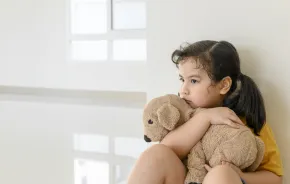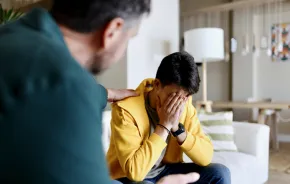 Parents have been dealing with the downsides of television as long as that shimmering screen has been around. Today, with access to unlimited content just a Hulu click away, they anxiously wonder: How much is too much? What shows are good shows? Are programs too violent? Too sexy?
Parents have been dealing with the downsides of television as long as that shimmering screen has been around. Today, with access to unlimited content just a Hulu click away, they anxiously wonder: How much is too much? What shows are good shows? Are programs too violent? Too sexy?
Their concerns swung into extra-high gear in 2004, when the University of Washington’s own Dr. Dimitri Christakis, a professor of pediatrics, found that early TV viewing can increase kids’ risk for later attention problems.
Parents everywhere quickly concluded that too much screen time could lead to attention deficit hyperactivity disorder (ADHD). Before long, Dora the Explorer morphed into Dora the Devil. Even Elmo found his way onto some parents’ “Don’t Watch” list. And when the American Academy of Pediatrics (AAP) told folks not to expose their tots younger than 2 to the tube, parents listened.
Some parents ratcheted those AAP suggestions right up to the next level. Many refused to allow their toddlers to share space with a switched-on set. Others banished the box to the garage.
“That’s an overreaction,” says Christakis. “Very small exposures to TV are fine. It’s like what we know about secondhand smoke: It’s bad for kids. But that doesn’t mean if someone is smoking two booths away, you should grab your toddler and run.”
The turn-off-the-TV strategy often backfires, says Patricia Nan Anderson, Ed.D., a Seattle-area parenting coach. “The more scarce television is, the more valuable it becomes,” she says. “The kids want it, and their friends have it. It’s foolish to think our kids can be kept from TV.” Christakis agrees. “TV is so woven into our fabric, it can’t be about eliminating it,” he says.
Strike a balance
What’s a more realistic approach? Teach your kids how to be wise TV consumers, says Anderson. “Make sure they watch shows that have a pro-social message. Even if there’s conflict, the pro-social content should be there. The question you should ask is, how much violence does it take to get that content?”
Most kids’ shows — even on Disney or PBS — spend 15 of the show’s 22 minutes setting up the stories with examples of bad behavior, says Anderson. “They might want to show how mean the child next door is, but they end up broadcasting the problem for a much longer time than the solution.”
As Po Bronson and Ashley Merryman note in their book, NurtureShock, preschoolers can’t quite connect information at the end of a show to what happened earlier. The point — whether it’s a lesson about bullying or relationships or honesty — is lost on these kids.
That’s just one reason a group of Seattle broadcasters and early learning educators hope to launch Look, Listen and Learn, a locally produced TV program aimed at preschoolers. The 30-minute show combines puppetry, animation and music to promote school readiness, early learning and parent-child relationships, according to Val Thomas-Matson, the show’s producer and host.
“We want to help bridge the achievement gap,” she says. “We’d like viewers to have fun, learn and use this as a way to experience some of the things we do in the real community, such as going to the library to read books, or to the zoo to see animals.”
But raising the funds to produce the show — it will air on a local government station — has been challenging, because TV has considerable image issues (apart from the visual kind). “People really want to do right by their kids,” says Thomas-Matson. “There is so much information out there about how damaging TV is. These parents grew up with Sesame Street and Mister Rogers, but all of a sudden, there’s this short-term memory.”
Look for good programs
The truth is, current programs for kids aren’t all bad, says Christakis. In fact some shows aimed at preschoolers are terrific (go to commonsensemedia.org for reviews and ratings). The big slide into lower-quality programming happens later, when the kids reach school age.
“The shows transition from quality entertainment programming to prime-time offerings that are not appropriate for them,” says Christakis. “That’s when parents need to get involved.”
They can do that by watching television with their children, especially if the kids are younger than age 3, says Dr. Michelle Terry, a Seattle Children’s pediatrician. “Television can be a fun and educational part of a child’s daily routine if programs are selected with care.”
It takes work to find good programs, says Christakis. “In the old days, you’d just go to PBS for that. Now, you can find top programming on the Discovery Channel.” He particularly likes the Discovery Channel’s Life episodes. “They can inspire kids. Even the ‘kill your television’ crowd thinks they’re good.”
And don’t discount the Food Network. After all, what child doesn’t like to play chef? “These shows can really get kids interested in cooking,” says Christakis.
Parents should use these programs to help expose their kids to innovative ideas and activities — then reinforce those ideas with real-life examples and excursions, he says. “If you watch a show about a snow leopard on the Discovery Channel, Google ‘snow leopard.’ Then take your child to the zoo to see one.”
Should parents steer their kids toward educational programming? “All TV is educational, whether it’s Sesame Street or American Idol,” says Christakis. “The question we should ask is, what are these shows actually teaching?”
When kids view content you’re not happy with — and they will — discuss the plot, the characters and the message with them. Pay extra attention to shows that feature sex and violence. Most of the time, those things are portrayed without consequences, Christakis says. “It’s up to parents to put them back in. Make sure your child understands that.”
And always remember: There are other options. “Parents sometimes say, ‘My kid just needs to watch TV to chill out,’” says Anderson. “Looking at the ceiling, reading a book and pulling weeds work, too.
Linda Morgan is ParentMap’s associate editor and the author of Beyond Smart: Boosting Your Child’s Social, Emotional, and Academic Potential.









